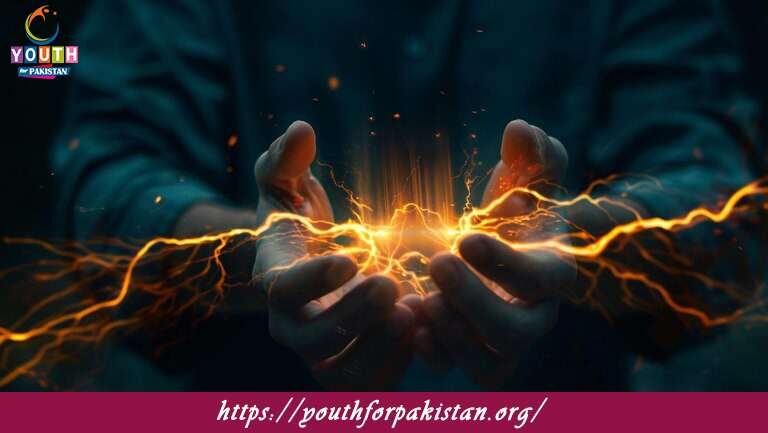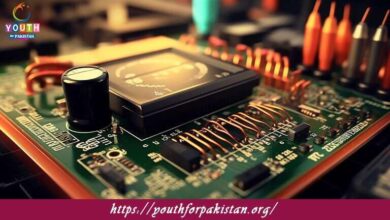10th Class Physics Chapter 13 MCQs with Answers

Understand the fundamentals of electrostatics with these comprehensive MCQs. Topics include Coulomb’s law, electric fields, and capacitors. Featuring trending keywords like “electrostatics MCQs for competitive exams” and “electric field quiz for 10th class,” this guide ensures exam success.
Which particle in an atom carries a positive electric charge?
a) Proton
b) Electron
c) Neutron
d) Positron
Two like charges each other, while two unlike charges each other.
a) Attract, attract
b) Repel, repel
c) Attract, repel
d) Repel, attract
The SI unit of electric charge is:
a) Volt
b) Coulomb
c) Ohm
d) Tesla
When an insulating material is rubbed with another material, it becomes electrically charged by the process of:
a) Conduction
b) Induction
c) Charging by friction
d) Charging by contact
The process of transferring charge without direct contact between two objects is called:
a) Conduction
b) Induction
c) Charging by friction
d) Charging by contact
An electric field is produced by:
a) Stationary charges only
b) Moving charges only
c) Both stationary and moving charges
d) None of the above
The property of an object to resist changes in its electric state is called:
a) Capacitance
b) Resistance
c) Conductance
d) Inductance
The force between two point charges is directly proportional to the:
a) Magnitude of charges and distance between them
b) Magnitude of charges only
c) Distance between them only
d) None of the above
Coulomb’s law describes the force between two charges as:
a) Directly proportional to the product of the charges and inversely proportional to the square of the distance between them
b) Directly proportional to the square of the distance between them and inversely proportional to the product of the charges
c) Inversely proportional to the square of the distance between them and directly
proportional to the product of the charges
d) Inversely proportional to the product of the charges and directly proportional to the square of the distance between them
The electric field inside a conductor is:
a) Zero
b) Infinite
c) Constant
d) Variable
Electric field lines:
a) Intersect each other
b) Form closed loops
c) Do not have a definite pattern
d) Originate from positive charges and terminate on negative charges
The process of removing excess charge from an object by allowing it to flow into the
Earth is called:
a) Charging by friction
b) Charging by contact
c) Grounding
d) Induction
An electrically charged object:
a) Always has an excess of protons
b) Always has an excess of electrons
c) Always has an excess of neutrons
d) Has an imbalance of protons and electrons
An electric dipole consists of:
a) Two positive charges
b) Two negative charges
c) One positive and one negative charge
d) One positive charge and one neutral charge
The potential energy of a charge in an electric field depends on its:
a) Magnitude and the direction of the field
b) Sign and the direction of the field
c) Magnitude and the location in the field
d) Sign and the location in the field
Electric potential is measured in:
a) Newtons
b) Volts
c) Coulombs
d) Amperes
The work done in moving a charge in an electric field is equal to:
a) The electric field strength
b) The electric potential difference
c) The charge of the object
d) None of the above
The process of temporarily neutralizing an object by bringing it close to a charged object is called:
a) Charging by friction
b) Charging by contact
c) Grounding
d) Induction
The electric field at a point due to a point charge is directly proportional to the:
a) Magnitude of the charge
b) Square of the distance from the charge
c) Product of the charge and the distance from the charge
d) Inverse of the square of the distance from the charge
An electrically neutral object:
a) Has an equal number of protons and electrons
b) Has an equal number of protons and neutrons
c) Has an equal number of electrons and neutrons
d) Has an imbalance of protons and electrons
The unit of electric field strength is:
a) Volts
b) Coulombs
c) Newtons
d) Newtons per coulomb
The electric field inside a conductor is zero because:
a) The conductor is neutral
b) The charges inside the conductor are immobile
c) The net charge inside the conductor is zero
d) The electric field lines are parallel to the surface of the conductor
The electric field strength at a point outside a charged sphere is the same as if:
a) The entire charge of the sphere were concentrated at its center
b) The entire charge of the sphere were uniformly distributed over its surface
c) The charge were distributed inside the sphere uniformly
d) The charge of the sphere were spread out indefinitely in all directions
The electric field inside a capacitor is:
a) Zero
b) Infinite
c) Constant
d) Variable
The electric potential at a point in an electric field depends on:
a) The magnitude of the point charge
b) The direction of the electric field
c) The magnitude of the electric field
d) The location of the point in the field
When a positively charged object is brought near a neutral object, the near side of the neutral object becomes:
a) Positively charged
b) Negatively charged
c) Neutral
d) None of the above
A positively charged rod is brought near an electroscope. The leaves of the electroscope:
a) Collapse
b) Diverge
c) Remain unaffected
d) Oscillate
When an object gains electrons, it becomes:
a) Positively charged
b) Negatively charged
c) Neutral
d) None of the above
A charged rod is brought near a negatively charged sphere. The sphere will:
a) Attract the rod
b) Repel the rod
c) Remain unaffected
d) Oscillate
The process of transferring charge by direct contact between two objects is called:
a) Conduction
b) Induction
c) Charging by friction
d) Charging by contact
Two point charges of +2 μC and -4 μC are placed 3 meters apart. What is the magnitude
of the electric force between them?
a) 2 N
b) 6 N
c) 8 N
d) 12 N
Two point charges, +Q and -Q, are placed at a distance ‘r’ from each other. The electric field at a point on the line joining the charges and at a distance ‘x’ from +Q is given by:
a) E = k(Q/r)
b) E = k(Q/x^2)
c) E = k(Q/(r-x))
d) E = k(2Q/r)
A charge of 10 μC is placed at a point in space. What is the electric potential at a point 2
meters away from the charge?
a) 18 V
b) 45 V
c) 90 V
d) 180 V
A charge of 8 μC is placed at the origin (0,0) in an xy-plane. What is the electric potential at point P(3,4)?
a) 10 V
b) 24 V
c) 30 V
d) 40 V
If the distance between two point charges is halved, the electric force between them becomes:
a) Halved
b) Doubled
c) Quadrupled
d) Unchanged
If the magnitude of the charge on an object is doubled, the electric field strength at a distance from the object will be:
a) Doubled
b) Halved
c) Quadrupled
d) Unchanged
The electric field inside a hollow conducting sphere is:
a) Zero
b) Infinite
c) Constant
d) Variable
The direction of an electric field at a point is the direction of the force that would be experienced by a:
a) Positive test charge placed at that point
b) Negative test charge placed at that point
c) Neutral test charge placed at that point
d) Test charge placed at infinity
The process of charging a conductor by bringing it into contact with another charged object is called:
a) Charging by friction
b) Charging by contact
c) Grounding
d) Induction
A positively charged rod is brought near a neutral sphere. The side of the sphere that is farthest from the rod becomes:
a) Positively charged
b) Negatively charged
c) Neutral
d) None of the above
An electroscope can be charged by:
a) Grounding
b) Induction
c) Charging by friction
d) Charging by contact
Which of the following statements is true about the charge of an electron?
a) The charge is positive
b) The charge is negative
c) The charge is zero
d) The charge is variable
An electroscope can be discharged by:
a) Grounding
b) Induction
c) Charging by friction
d) Charging by contact
The process of transferring charge by the movement of electrons in a substance is called:
a) Conduction
b) Induction
c) Charging by friction
d) Charging by contact
The process of redistributing charges on an object when it is brought near a charged object is called:
a) Charging by friction
b) Charging by contact
c) Grounding
d) Induction
The electric potential energy of a charge in an electric field is:
a) Directly proportional to the magnitude of the charge
b) Directly proportional to the magnitude of the electric field
c) Inversely proportional to the distance from the charge
d) Inversely proportional to the distance from the source of the electric field
A positively charged rod is brought near an uncharged electroscope. The leaves of the electroscope:
a) Collapse
b) Diverge
c) Remain unaffected
d) Oscillate
The electric potential at a point in an electric field is measured in:
a) Joules
b) Volts
c) Coulombs
d) Amperes
An electric field is a vector quantity because it has:
a) Magnitude and direction
b) Magnitude only
c) Direction only
d) Variable intensity
Two positive point charges of magnitude Q and 2Q are placed 4 meters apart. What is the magnitude of the electric force between them?
a) 2Q
b) 3Q
c) 4Q
d) 6Q
An electric field is directed away from a positive charge and towards a negative charge. This is because:
a) Electric field lines originate from positive charges and terminate on negative charges
b) Electric field lines originate from negative charges and terminate on positive charges
c) Electric field lines are always directed away from charges
d) Electric field lines are always directed towards charges
A negatively charged rod is brought near a neutral sphere. The sphere will:
a) Attract the rod
b) Repel the rod
c) Remain unaffected
d) Oscillate
The electric field strength at a point due to a positive point charge is zero at a distance:
a) Equal to the charge
b) Greater than the charge
c) Less than the charge
d) Infinite
The magnitude of the electric force between two charges is halved when the distance between them is:
a) Doubled
b) Quadrupled
c) Halved
d) Quartered
The direction of the electric field at a point is the direction of the force that would be experienced by a:
a) Neutral test charge placed at that point
b) Positive test charge placed at that point
c) Negative test charge placed at that point
d) Test charge placed at infinity
The potential difference between two points is measured in:
a) Joules
b) Volts
c) Coulombs
d) Amperes
The electric potential at a point in an electric field depends on:
a) The magnitude of the point charge
b) The direction of the electric field
c) The magnitude of the electric field
d) The location of the point in the field
When a negatively charged object is brought near a neutral object, the near side of the neutral object becomes:
a) Positively charged
b) Negatively charged
c) Neutral
d) None of the above
The process of charging an object by rubbing it with another material is called:
a) Charging by friction
b) Charging by contact
c) Grounding
d) Induction
The process of charging an object by induction:
a) Increases the charge on the object
b) Decreases the charge on the object
c) Does not change the charge on the object
d) Depends on the charge on the inducing object
If you are interested to enhance your knowledge regarding Physics, Chemistry, Biology, and Computer please click on the link of each category, you will be redirected to dedicated website for each category.





